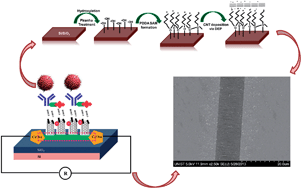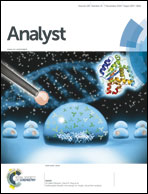Electrical immunosensor based on dielectrophoretically-deposited carbon nanotubes for detection of influenza virus H1N1†
Abstract
The influenza virus has received extensive attention due to the recent H1N1 pandemics originating from swine. This study reports a label-free, highly sensitive, and selective electrical immunosensor for the detection of influenza virus H1N1 based on dielectrophoretically deposited single-walled carbon nanotubes (SWCNTs). COOH-functionalized SWCNTs were deposited on a self-assembled monolayer of polyelectrolyte polydiallyldimethyl-ammonium chloride (PDDA) between two gold electrodes by dielectrophoretic and electrostatic forces, which resulted in reproducible, uniform, aligned, and aggregation-free SWCNT channels (2–10 μm in length). Avidin was immobilized onto the PDDA–SWCNT channels, and viral antibodies were immobilized using biotin–avidin coupling. The resistance of the channels increased with the binding of the influenza viruses to the antibodies. These immunosensors showed linear behavior as the virus concentration was varied from 1 to 104 PFU ml−1 along with a detection time of 30 min. The immunosensors with a 2 μm channel length detected 1 PFU ml−1 of the influenza virus accurately (R2 = 0.99) and selectively from MS2 bacteriophages. These immunosensors have the potential to become an important component of a point-of-care test kit that will enable a rapid clinical diagnosis.


 Please wait while we load your content...
Please wait while we load your content...